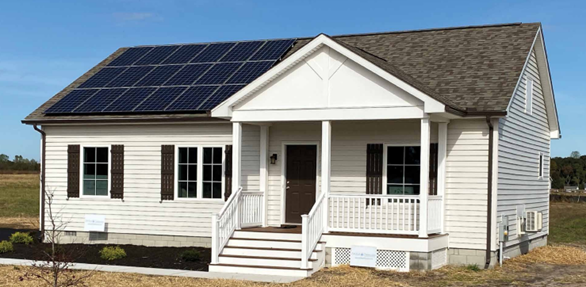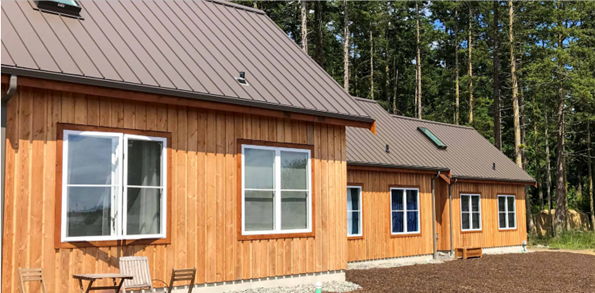 |
|
June 2023 Newsletter |
Zero Energy Ready Homes are Affordable
One of the most valuable aspects of the DOE Zero Energy Ready Home program is the wide variety of housing types that can achieve ZERH certification. Over the past year, the program has been working on program versions specific to multifamily and manufactured housing, a testament to the program’s growth and applicability across housing types. In our last two newsletters, we have highlighted examples of both custom and production homes that achieve ZERH certification. In this edition, we will look at how ZERH is changing the narrative when it comes to affordable housing.
When thinking about high-performance, energy efficient, and healthy homes, “affordable” is probably not the first word that comes to mind. In fact, it’s more likely, “that sounds expensive.” But ZERH builders and organizations across the country are proving that ZERH certification is not only possible, but an ideal solution for affordable housing because ZERHs deliver true value to the residents in the total cost of ownership. Over 15 states and local governments now reference the ZERH program in their low-income housing tax credits, incentive programs, and building codes. Additionally, 23 chapters of Habitat for Humanity across the country are registered ZERH partners who have developed 160 Habitat homes that achieved ZERH certification.
Below are some examples of some of the award-winning ZERH affordable housing projects across the country. You can find more information on these homes and others at the DOE Tour of Zero.
Beracah Homes- DESEU State Fair House- Lincoln, Delaware
2022 Housing Innovation Award Grand Winner
 Beracah Homes prides itself on building some of the strongest, most efficient homes in the mid-Atlantic region. They are a pioneer of off-site modular construction, which helps them reduce labor and material costs by streamlining their construction process in a factory environment. These measures improve their homes’ affordability, and this home in particular was designed with affordability in mind. By designing this home to be compact and include minimal details, Beracah saves significant material and construction costs, which then translates into reducing the sale price for buyers, making the home accessible to lower-income consumers. This home is their Sundial model, with just over 1200 square feet of living space, including two bedrooms and two bathrooms. It also includes solar electricity, central heating and air conditioning, and fresh air ventilation, along with many other energy-saving features. In a creative marketing move, Beracah built this home in partnership with Energize Delaware’s ZeMod program at the Delaware State Fair grounds to allow people to tour the home and generate interest in the program.
The ZeMod program’s mission is to provide affordable zero energy modular homes that meet the highest standards of durability, energy efficiency, comfort, and indoor air quality. The program also provides services like downpayment assistance, access to suitable and affordable lots, and homebuyer counseling to become mortgage ready. Even in the short term, ZeMod homeowners save with access to low-interest financing and no electric and heating costs. In the long term, these homeowners are investing in an asset that will hold its value over time because of its reliability and resiliency. Tour this home here.
Habitat for Humanity South Sarasota - The Venetian at Eldron - North Port, Florida
2021 Housing Innovation Award Winner
 Habitat for Humanity is known nationally and internationally for its simple mission, to build decent and affordable homes around the world in partnership with families in need of a decent place to live. No matter where they are built, all Habitat houses follow these same guiding principles. Many Habitat chapters focus on energy efficiency and indoor air quality as a means to achieve high-quality, affordable homes. In South Sarasota, the local Habitat for Humanity chapter has been building Zero Energy Ready certified homes since 2013, when it committed to certify all its new homes under the program.
The home showcased here is part of a 5-home development built on contiguous lots in North Port, Florida. Because this area is susceptible to extreme weather, the home is not only affordable, energy efficient, and aesthetically pleasing, it is also built with concrete blocks and impact-resistant windows to withstand 160 mph winds. Habitat for Humanity South Sarasota prides itself on the resilient homes they build and are confident that these homes can last more than 100 years, well beyond a typical mortgage term.
The best evidence of this particular project’s success is the homeowner’s experience: “We simply love our energy-efficient home! Most important is the indoor air quality, supported by EPA Indoor airPLUS. We can breathe easier knowing we will save money on our energy costs while providing healthy indoor air quality for our children.” Even with Florida’s intense heat and humidity, this family only pays about $60 in monthly energy bills. Tour this home here.
Lopez Community Land Trust - Salish Way Cottages - Lopez Island, Washington
2021 Housing Innovation Award Winner
 Lopez Community Land Trust (LCLT) is a non-profit organization that serves the Lopez Island community through affordable housing, sustainable agriculture, and other rural development programs. The Land Trust was formed in 1989 to provide permanently affordable housing, permanently affordable access to land, and to develop and exercise responsible ecological practices to preserve, protect, and enhance the land’s natural attributes.
The Salish Way Cottages are an additional phase of the Common Ground development, which was initially completed by LCLT in 2009 as one of the first net zero affordable housing communities in the United States. The Salish Way Cottages, completed in 2021, are also affordable and net zero, building on LCLT’s principles of ecological responsibility. All the lumber for siding and trim was milled on the island, and some from trees were taken directly from the property. Almost all jobsite waste was separated on site and recycled at the Lopez Community’s recycling facility. Several other construction materials were also sourced from the island, including the aggregate and rock used in the cottages’ foundations.
These cottages are built to last – not only are the structures themselves resilient, but they also are built to allow their occupants to age in place with stepless entries and first floor bedrooms and bathrooms. This community perfectly embodies the ideals of responsible, long-term, affordable housing. Tour the Salish Way Cottages here.
|